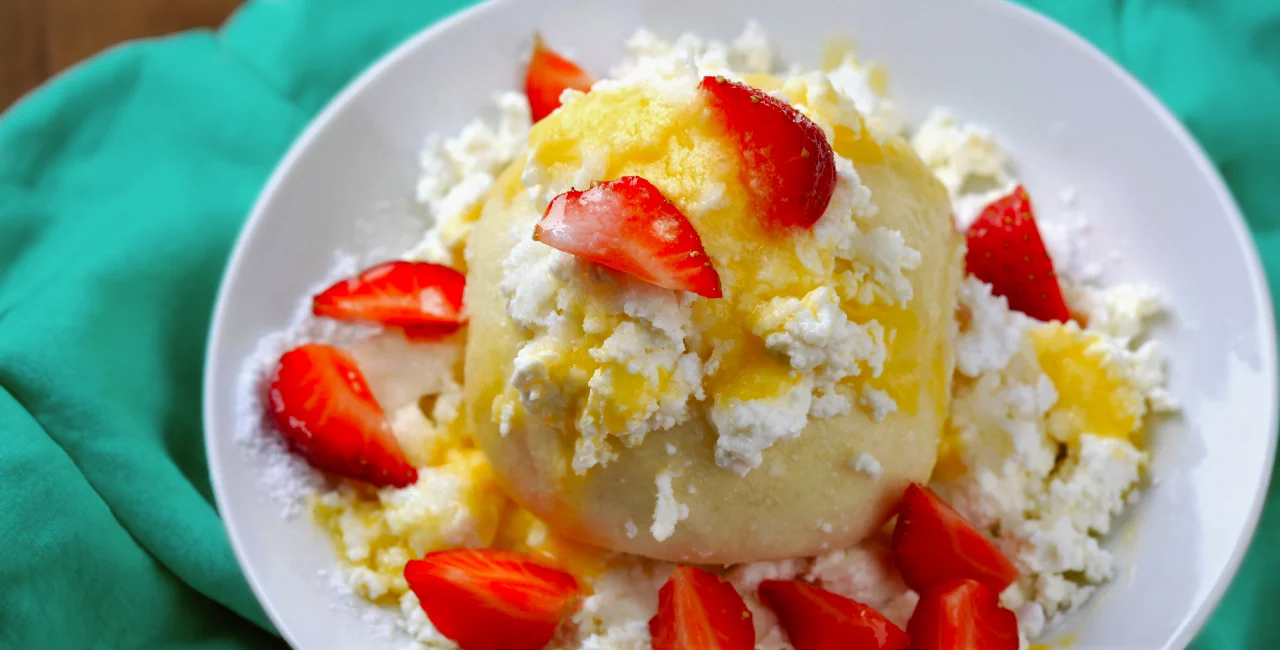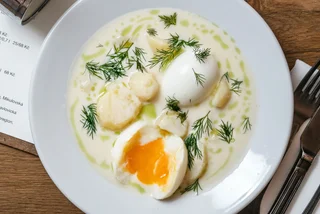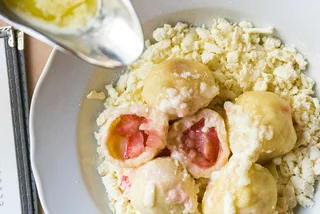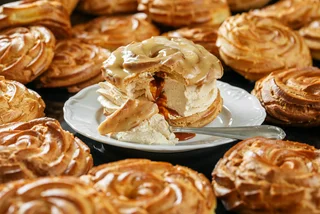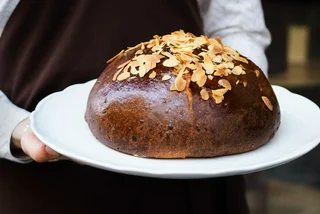They are fluffy (the original word was kynuté), filled with fruit, and served in fragrant melted butter. It’s time to taste the famous dumplings that guests hike to Prague Castle's Kuchyň restaurant for. One dumpling is enough to fill your tastebuds with delicious joy, especially if the dough has properly risen so that it is fluffy and ready to be wrapped in juicy seasonal fruit.
cooking tips
The recipe requires the same procedure as a classic bun dumpling (klasický houskový knedlík), minus the bun. Add the coarse flour (hrubá mouka) and salt, rolled yeast, sugar, and eggs into a bowl. The last ingredient is the slightly warmed milk, which encourages the yeast to start working. A well-kneaded dough should be smooth, elastic, and just stiff enough.
And what about the leaven (rozkvas)? In the case of dumplings, it is optional because the dough does not contain fat, which would make it difficult for the yeast to work. If you're used to sourdough starter, let it rise with some of the milk, sugar, yeast, and a tablespoon of flour and stir it into the sifted flour with a pinch of salt and an egg.
The future dumplings go through several stages. The first time the dough rises in the mixing bowl (which you should leave covered with a towel!) it doubles in volume. The dumplings are then rolled out into individual portions: the 100-gram pieces are rolled into firm balls and left to sit for 10 minutes under the towel before adding their filling.
The next step involves stretching the dough loaves into round patties, which are filled and closed like a pouch. The top is tightened firmly and rolled into a regular shape. There are several reasons for this: it makes the dumplings look nice, but above all, the excess air is released from the dumplings so that the dough does not shrink when cooking.
CHEF’S TIP: The thickness of the dough should be uniform, otherwise the thinner layers risk boiling or being torn by escaping steam.
The ratio of dough to filling depends on your taste. In the Kuchyň restaurant, each dumpling can hold 50 g of breadcrumbs or 70 g of fruit. The thickness of the dough should be uniform, otherwise, the thinner layers risk being torn by escaping steam.
Filled dumplings need one more step before they’re ready to eat. Cooks place them on an oiled baking tray and sprinkle them with water from a spray bottle so that they don't dry out over the next 20 to 45 minutes – the exact final rising time depends on the ambient temperature and the looseness of the dough.
The pros cook the dumplings in a kettle: thanks to the steam, they can do it in 16 minutes. Home cooks are likely to opt for a steamer fan (napařovací vějíř) or a saucepan, which is worth buttering beforehand. The dumplings tend to stick to the steamer, as well as sticking together if they don’t have enough room, as the heat causes air pockets in the dough to expand; since they are full of evaporating water, the dumplings continue to expand as they cook.
GRANDMA’S TIP: Old Austrian cookbooks recommend adding a little milk to the water in the steaming pot, which is said to "sweeten" the steam and flavor the dumplings.
Pierce the cooked dumplings with a fork! The steam accumulated inside must come out, otherwise, the dough will curdle. Immediately afterward, brush the still-hot dumplings with butter.
The filling is based on the fruits that are in season. In June, you will enjoy dumplings with whole strawberries and rhubarb, which are sliced 3 to 4 centimeters thin and sweetened with icing sugar. They are served with fresh strawberries, pickled rhubarb, and grated cottage cheese from Krasolesí, with sugar and a good dose of butter – at least 50 g per dumpling!
During the summer, you can swap strawberries for apricots; the fresh fruit sprinkled with sugar is hidden in the dough, while the sauce of cooked apricots also serves as a topping together with the curd and butter. In autumn, plums are a natural fit for the recipe, while winter is the best time for rum-diluted marmalade (povidla ředění rumem), with the classic sprinkling of poppy seeds and icing sugar.
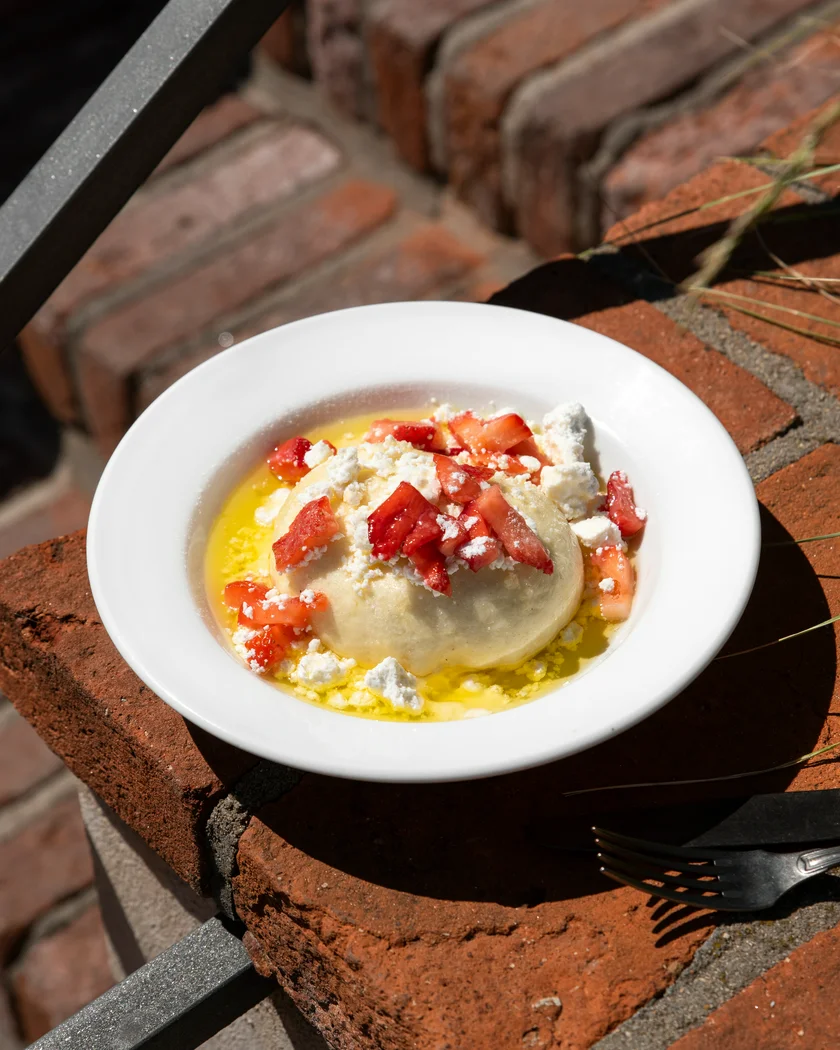
Ingredients
For 16 dumplings:
- 1 kg coarse flour
- 20 g salt
- ½ cube of fresh yeast
- 20 g sugar
- 1 egg
- ½ l milk, slightly warmed
- fruit to taste
- sugar for the filling and for serving
- butter for spreading and pouring over the dumplings
- hard cottage cheese for grating
method
- 1.Add 100 g of flour, the salt, and then the remaining flour in a bowl. This will separate the salt, which could slow down the yeast activity.
- 2.Add the yeast, sugar, and eggs. Do not stir the ingredients yet!
- 3.Pour in a pint of lukewarm (not hot!) milk and mix for 10 to 15 minutes, ideally using a food processor, which will help you work up a smooth mass.
- 4.Cover the non-sticky dough with a tea towel and leave it in a warm place to rise for about 15 minutes.
- 5.Weigh and roll out the risen dough into 100-gram balls. Cover them with a tea towel and let them rest for 10 minutes.
- 6.Fill the dough with fruit and shape it into dumplings. Sprinkled lightly with water, they will rise for 20 to 45 minutes.
- 7.Steam the rested dumplings – this will take about 16 minutes.
- 8.Prick the finished dumplings with a fork to prevent the filling from spilling out and brush with butter.
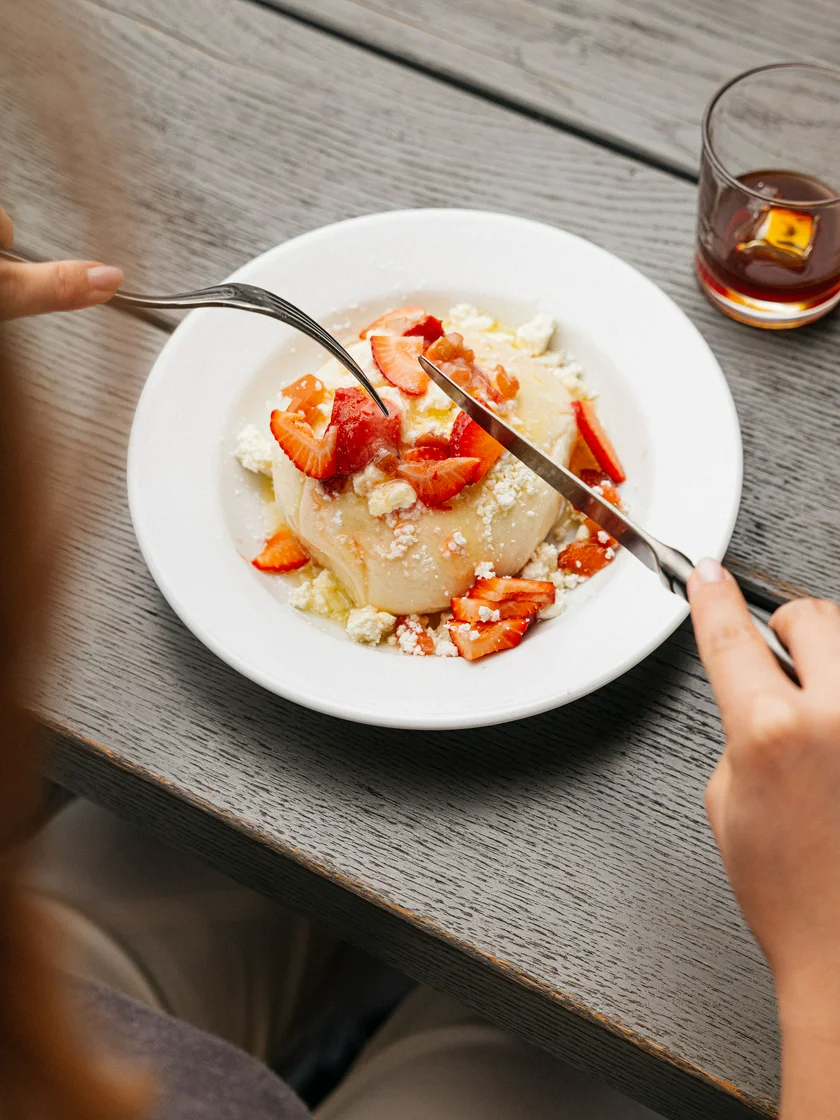
FUN FACT: Fruit dumplings are considered a specialty of Viennese cuisine, but the Austrians themselves give some of the credit to the Czechs, specifically to Czech cooks who served in Austrian homes. You can tell the difference at a glance! Viennese dumplings are usually larger and steamed, and most people serve them with marmalade, poppy seeds, sugar, and butter.
In the Czech Kitchen is a weekly column written in cooperation with the culinary experts from Ambiente. Established in 1995, the Prague-based collective of pubs, restaurants, and fine-dining outlets has transformed the Czech culinary landscape and lent to the widespread awareness of quality food service and production in Czechia. Follow their socials or book your table at www.ambi.cz.












 Reading time: 5 minutes
Reading time: 5 minutes 